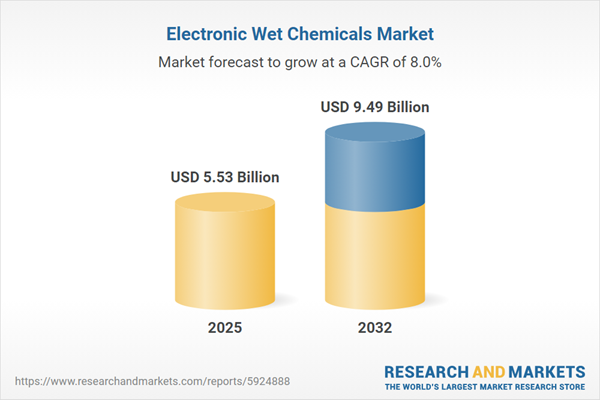Speak directly to the analyst to clarify any post sales queries you may have.
The electronic wet chemicals market is advancing as organizations address changing regulations, diversified supply chains, and sustainable manufacturing expectations. Strategic adaptability and compliance are now central for senior executives seeking stable growth and minimized risk in this evolving sector.
Market Snapshot: Growth Trajectory in the Electronic Wet Chemicals Market
Rapid innovation in semiconductor manufacturing is shaping the growth of the electronic wet chemicals market. As demand rises for advanced process nodes, new production technologies and tailored chemical formulations are being adopted across global supply chains. Producers deliver specialized chemicals to ensure both accuracy and reliability in the manufacturing of integrated circuits and emerging electronic devices. The rise of Asian suppliers leveraging regionalized, large-scale production has shifted competitive strategies, pushing companies to reconsider procurement and partnership models. Implementing digital tools is also modernizing logistics and real-time process control, contributing to overall manufacturing efficiency and performance improvements across the sector.
Scope & Segmentation of the Electronic Wet Chemicals Market
This report offers senior executives a concise view of the critical operational drivers and segmentation shaping both short-term decisions and long-range strategies within the electronic wet chemicals industry. The following core areas provide the structure for market assessment:
- Product Types: Includes cleaning chemicals, CMP slurries, etching agents, photoresists, developers, and stripping chemicals. Each product is designed to meet changing process demands and enhance efficiency in complex environments.
- Applications: Covers wafer cleaning, resist coating, and precision etching solutions that serve semiconductor manufacturing and the development of next-generation display technologies.
- End Use Industries: Supplies target semiconductor production, advanced display manufacturing, LED fabrication, and solar energy sectors, supporting integration within specialized industry workflows.
- Purity Grades: Spans a broad purity scale from high to ultra-high, ensuring compliance with stringent production standards for both large-scale manufacturing and research and development.
- Forms: Available as liquids and powders to fit diverse production lines and accommodate facility-specific integration needs.
- Regions: Market activities extend across the Americas, Europe, Middle East, Africa, and Asia-Pacific, with emphasis on China, Japan, India, and Southeast Asia. Regional dynamics reflect local policies, technical requirements, and varied demand growth.
- Companies Monitored: In-depth analysis covers Merck KGaA, BASF SE, Dow Inc., JSR Corporation, Fujifilm Holdings Corporation, Entegris, Avantor, Mitsui Chemicals, Hitachi Chemical, and Element Solutions, focusing on their innovation and market strategies.
Key Takeaways for Senior Decision-Makers
- Ultra-high purity chemicals are essential for precision and reliability in electronics manufacturing, directly supporting quality in advanced production.
- Sustainable manufacturing practices, such as green chemistry and improved waste recycling, are becoming central in long-term compliance and operational strategy.
- Resilient supply structures, including regional manufacturing and local supplier relationships, help offset regulatory changes and geopolitical uncertainties.
- Digital analytics such as digital twins and lifecycle monitoring enhance asset management and ongoing optimization, supporting plant operators and suppliers.
- Collaboration between manufacturers and chemical suppliers allows development of tailored chemical solutions for evolving electronics production needs.
Tariff Impact: Navigating Regulatory and Sourcing Challenges
Shifts in tariff policies, particularly affecting U.S.-centered operations, are prompting manufacturers to update sourcing and production approaches. Investing in regional capacity, diversifying suppliers, and forging new alliances has become critical for supply chain resilience and sustained operations as industry networks grow more interconnected and regulations shift globally.
Methodology & Data Sources
This report is built on comprehensive secondary research, direct interviews with key industry stakeholders, and analysis of current regulatory and technological movements. Findings are cross-validated to ensure accurate, actionable insights for executive planning and strategy.
Why This Report Matters
- Equips leaders to anticipate and act on technological change, regulatory shifts, and the increasing importance of sustainability in the electronic wet chemicals industry.
- Supports organizations in strengthening adaptable, compliant supply chains, positioning them to navigate ongoing industry transition.
- Provides a thorough overview of the combined operational, regional, and compliance factors that guide strategic planning and sustainable market growth.
Conclusion
This executive summary delivers actionable intelligence to help organizations enhance efficiency, reduce operational risk, and advance their sustainability goals in the evolving electronic wet chemicals market landscape.
Additional Product Information:
- Purchase of this report includes 1 year online access with quarterly updates.
- This report can be updated on request. Please contact our Customer Experience team using the Ask a Question widget on our website.
Table of Contents
3. Executive Summary
4. Market Overview
7. Cumulative Impact of Artificial Intelligence 2025
Companies Mentioned
The companies profiled in this Electronic Wet Chemicals market report include:- Merck KGaA
- BASF SE
- Dow Inc.
- JSR Corporation
- Fujifilm Holdings Corporation
- Entegris, Inc.
- Avantor, Inc.
- Mitsui Chemicals, Inc.
- Hitachi Chemical Co., Ltd.
- Element Solutions, Inc.
Table Information
| Report Attribute | Details |
|---|---|
| No. of Pages | 185 |
| Published | October 2025 |
| Forecast Period | 2025 - 2032 |
| Estimated Market Value ( USD | $ 5.53 Billion |
| Forecasted Market Value ( USD | $ 9.49 Billion |
| Compound Annual Growth Rate | 8.0% |
| Regions Covered | Global |
| No. of Companies Mentioned | 11 |







